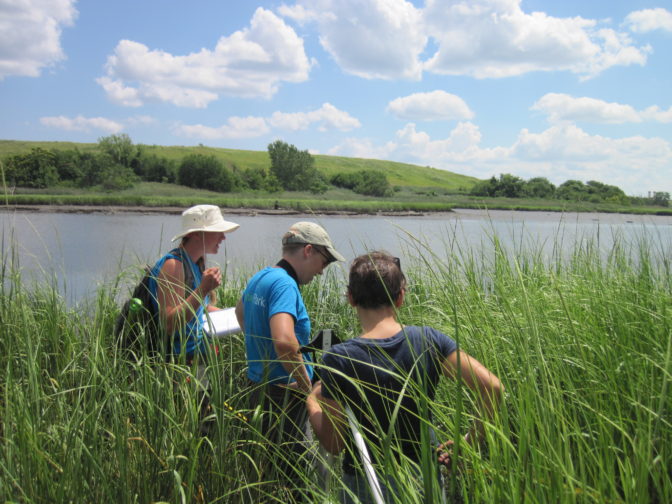Wetland Restoration Monitoring

Staff and interns collect data at the North Park Wetland Restoration site.
In mid-August, Freshkills Park staff and interns conducted the annual monitoring of the North Park Wetland Restoration. Each year we record how the native plants are doing, whether any invasive plant species are coming back in, and what kinds of wildlife are using the restored site.
The North Park Wetland Restoration was completed in 2013 and encompasses 1.8 acres in the northeast corner of North Park, along Main Creek and next to the William T. Davis Wildlife Refuge. The site had previously been overrun with Phragmites australis, an invasive reed. As part of the restoration efforts, goats were used to clear the invasive plants, and the land was re-sloped to match the nearby wetland shoreline elevations. A native plant palette of both low marsh and high marsh species was then planted.
We’ve been able to show that the native plantings are thriving, and important wildlife are using the site. For example, this year we spotted muskrat burrows and wading birds, and in past years we’ve seen evidence of diamondback terrapin turtles.
There are permanent transects established at the site, which ensures that we’re making accurate comparisons from year to year of the same areas. We stretch a measuring tape from the shoreline up to permanent stakes that mark the transects, and then use a quadrat (which is basically a PVC square of a set size) at locations along the transect to take measurements within it. These measurements include variables such as stem height, plant species present, percentage of ground cover, and any signs of wildlife. From these measurements we can make comparisons to previous years and observe how the restoration plantings are faring and how the site is changing over time.
This year’s environmental monitoring interns were Jocelyn Zorn and Josephine Hill-James. Each year, our environmental monitoring interns really help us out by assisting during the actual monitoring, analyzing the results, and writing up the report. We’re lucky to have this assistance in continuing to monitor this restoration at Freshkills Park.
It’s important to assess how wetland restorations such as this one are performing in the years following the restoration work. Otherwise, it’s hard to be sure which techniques are really working and which aren’t. It’s also important to see if something isn’t working so that we can take mitigating action, like removing Phragmites australis that may be moving back in. Wetland habitats are crucial for flood control, water filtration, and for a host of species that rely on them for their habitat. We are working to preserve the wetland areas that we have, and to figure out ways to make them more resilient and productive habitats.
The restoration itself was funded by a grant from the New York Department of State’s Office of Coastal, Local Government & Community Sustainability, as part of the Environmental Protection Fund.




